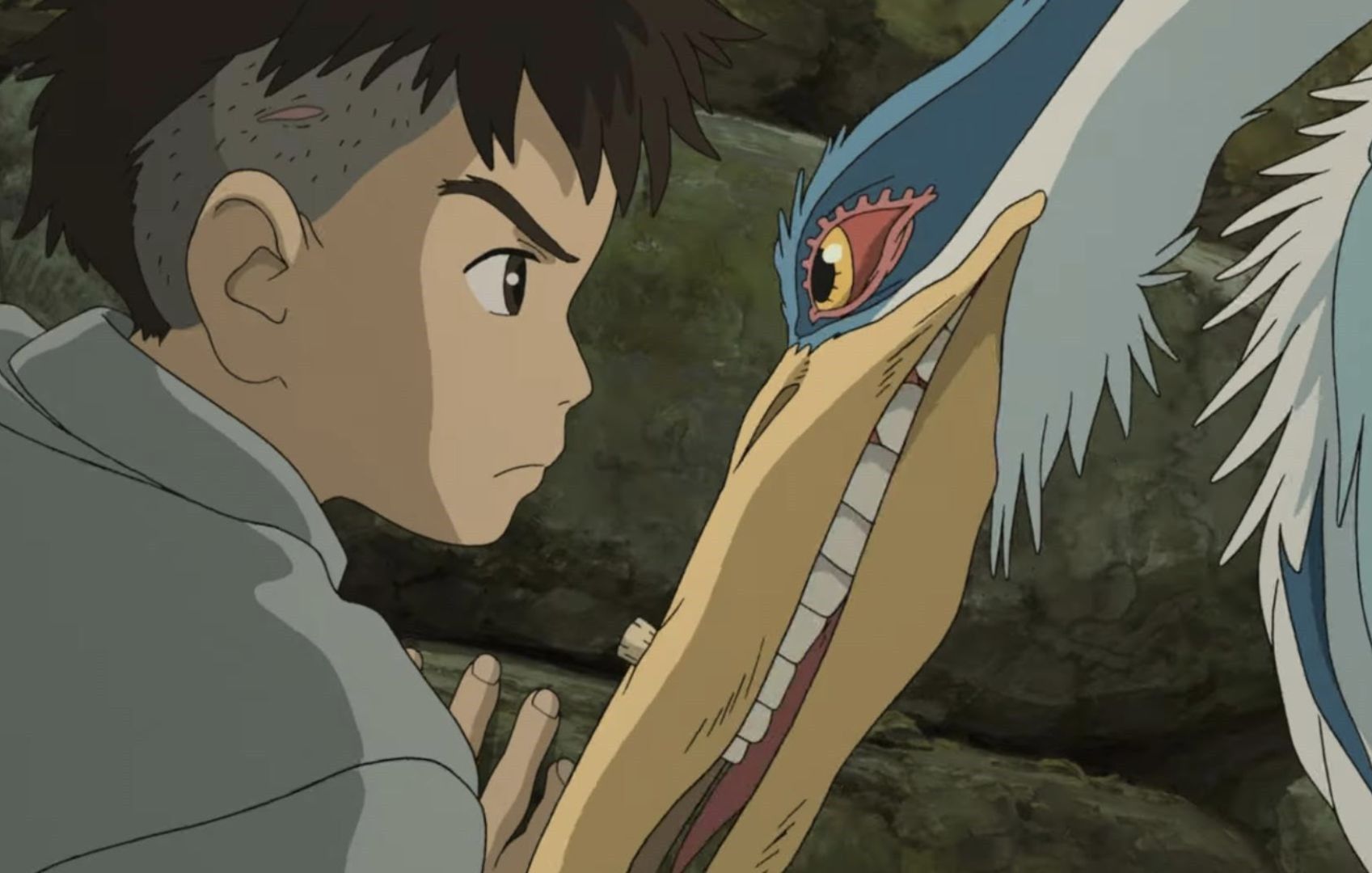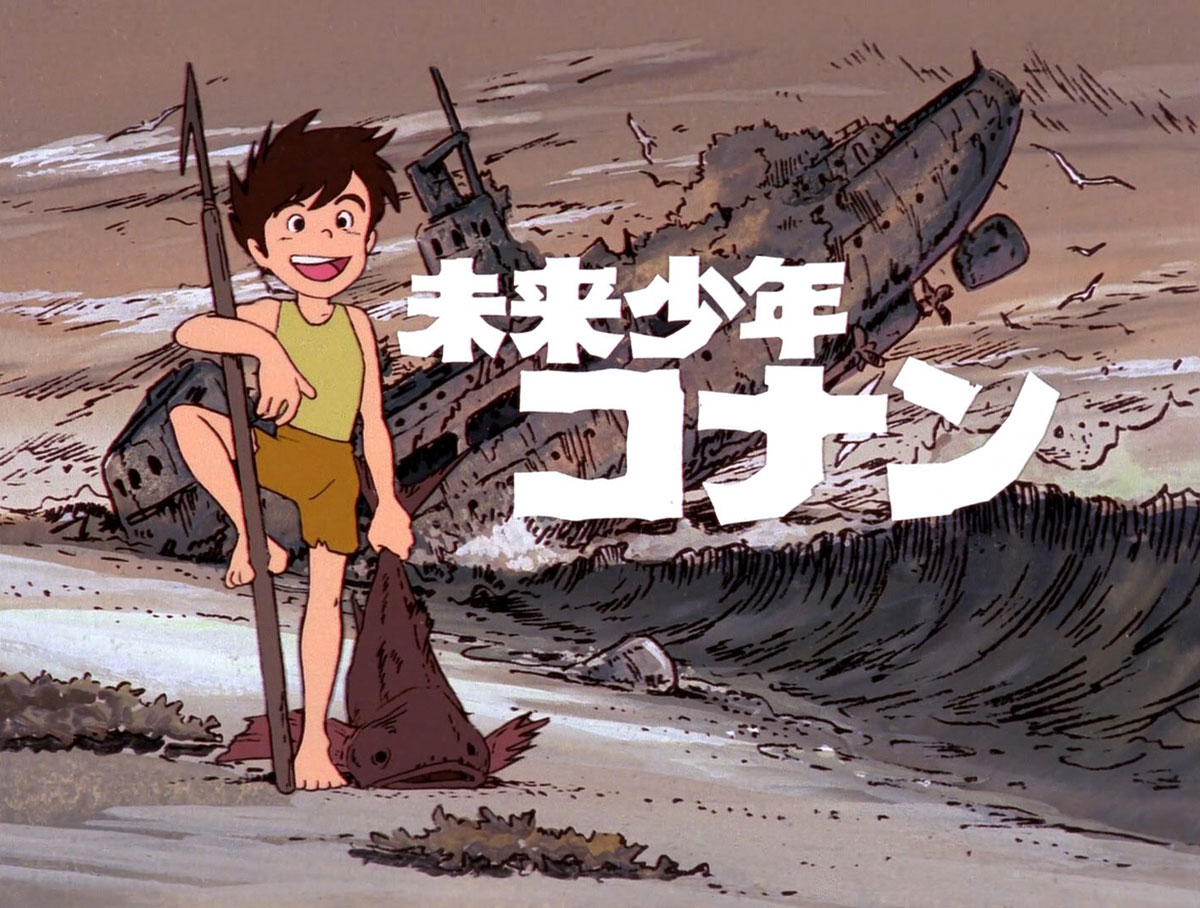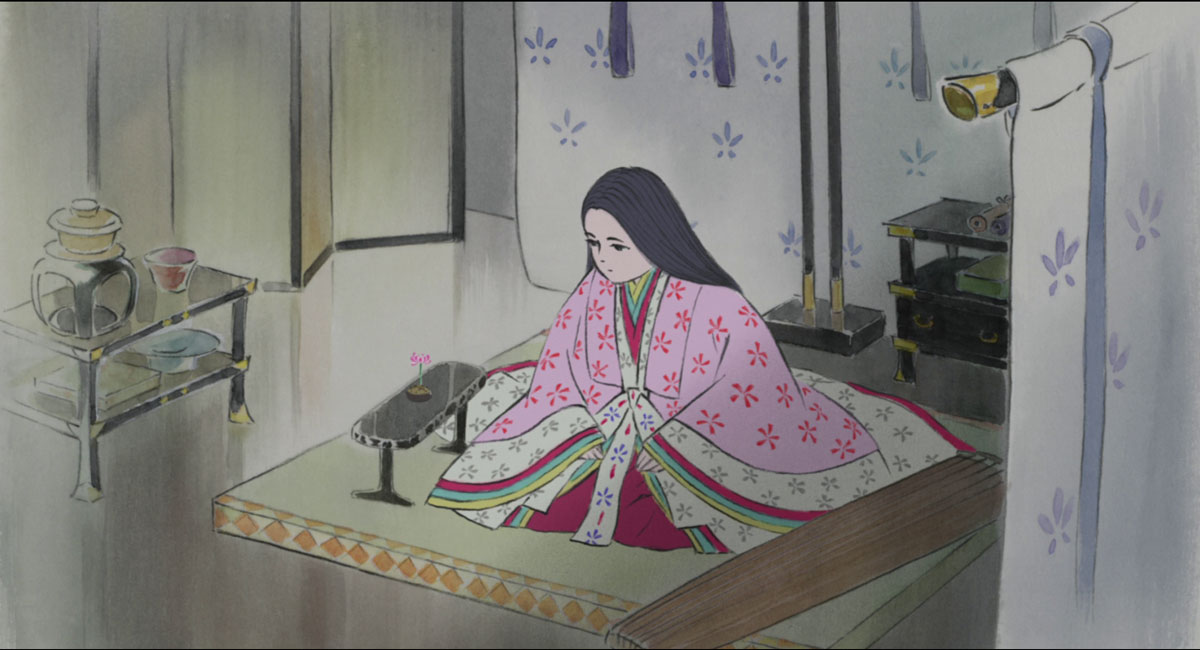Anime legend Hayao Miyazaki spirits audiences away for a new fantasy masterpiece.
by Bob Miller
Poor Sophie Hatter. She lives the dull life, day after day, mending hats at s. Her country is on the brink of war. And then, a visitor to the store turns out to be the Witch of the Waste, who transforms Sophie from a teenager into a withered, 90- year-old hag. To break the curse, Sophie must venture into the cold and forbidding mountains, seeking the help of a powerful wizard known as Howl. But rumor has it that Howl sucks the souls from the girls he captures, and eats their hearts.
Sophie’s journey soon involves an enchanted scarecrow, a young magician named Mark! and a mysterious mobile castle capable of spanning dimensions, and powered by a self-proclaimed fire demon, Calcifer, who has a secret connection with Howl. Alas for Sophie, the spell prevents her from telling anyone about it.
Howl’s Moving Castle is the latest fantastic foray by writer-director Hayao Miyazaki, the animation master whose previous film, Spirited Away, won an Oscar in 2003. British author Diana Wynne Jones published the original novel in 1986, and Miyazaki read it in 1999. According to Castle’s producer, Toshio Suzuki, “Mr. Miyazaki was attracted to two things: One was that a castle, usually something stationary, moves; the other was that an 18-year-old girl is magically transformed into a 90-year-old woman, and that the heroine is this old lady. We heard [from Jones] that David Bowie was the model for the Howl character, but Miyazaki did not know of David Bowie.”
Miyazaki told Starlog (in issue #305) that he made Spirited Away for 10- year-old girls. Who did he have in mind when he went ahead with Castle? After all, the definition of a Studio Ghibli film, according to Suzuki, is “Our encouragement and support to young children living in today’s ever-changing times.”
Suzuki tackles the question. “When Howl’s Moving Castle screened at the Venice International Film Festival, the 64-year-old Miyazaki wrote, ‘Can there be animation for old people? Howl’s Moving Castle was an attempt to answer that challenge,’ ” the producer says. “A film with a 90-year-old woman as the main character isn’t common, and for animation, it’s unheard of.
“In fact, Miyazaki was worried whether a film with an old lady as the heroine would work. However, a not-so-young female staff member said to him, ‘There are so many young movie heroines already; I think there could be a film with an old lady,’ and he was relieved. This film was also made for the young generation who are living in Japanese society with its many insecurities. They aren’t fully living their ‘youth,’ are worried about their future and have no confidence in themselves. Incidentally, and this is just a joke, but we’re frequently asked, ‘Who is Studio Ghibli films’ target audience?’ We say, ‘From age three to 100!’”
Away All Spirits
Castle took two-and-a-half years to complete, starting with storyboards and location ideas. “Sophie’s town was inspired by several towns in the Alsace region of France, especially Colmar, but there were other European influences as well,” says Stephen Alpert, Senior Vice President of Studio Ghibli’s International Division.
“They do lots of location scouting when they’re starting to film,” adds Pixar’s Pete Docter, writer-director of Monsters, Inc. and codirector of Castle’s translation into English. “Miyazaki goes there and just watches and looks. He doesn’t have a camera or sketch pad. And then when he gets back, he draws and paints everything from memory. There are people who follow along with cameras and recorders, and they draw things from real-life inspirations.”
Docter describes Miyazaki’s method of storytelling as “intuitive.” “From what I observed at Studio Ghibli, Miyazaki is the story crew,” he says. “It’s all him, the one guy who does it. And when he’s happy with it, he watches over the animators and the artists doing the backgrounds and so on. That’s opposed to us at Pixar, who have eight or 10 artists helping to craft the story. Miyazaki is able to work much more intuitively than we can, where we have to deal with it, talk about it, [grill] each other and intellectualize about it. Miyazaki had a desk right there in the middle of all the other animators. He was with the rest of the guys working away.”
In 1996, the Walt Disney Company arranged a deal with Tokuma Shoten, Ghibli’s parent corporation, to distribute Ghibli’s films worldwide (outside of Asia) both theatrically and on home video. When the time came in 2001 to dub Spirited Away into English, Miyazaki recommended Pixar creative gum John (Toy Story) Lasseter to oversee the project. “It was because John and Miyazaki-san are fans of each other’s work,” Docter relates. “John—and all of us at Pixar as well—has great admiration for what he has done. John and he have visited back-and-forth, and Miyazaki-san asked John to be involved with Spirited Away.
“Kirk Wise did most of the actual direction and working with the actors [for the English dub version], but John supervised in an executive producer-type of role. And when Howl’s Moving Castle came along, Miyazaki-san asked John to be involved and to actually direct it. John said he would love to, but he was right in the middle of his own film [Cora], so John asked me, ‘Would you be interested in doing it?’ I said, ‘Yeah!’ ”
“We aren’t familiar with other languages or countries, so it’s like sending our child overseas under the care of new parents,” explains Suzuki. “Fuckily, we have John as the executive producer and Pete as the dubbing director. They have our full trust, but Studio Ghibli takes part in approving the English translation of the script.”
“One thing that plays into this is that Pixar doesn’t benefit financially from the U.S. releases in any way,” Docter reveals. “We’ve really only been involved with the translations out of love and respect for Miyazaki’s films.”
For Castle, Docter teamed with producer-director Rick Dempsey, Senior Vice President of Disney Character Voices and Disney Character Voices International, who’s charged with ensuring character consistency throughout the Disney Universe worldwide. “Rick and I are pretty redundant in our roles, in terms of actually directing the actors,” Docter explains. “We were both involved in the casting and making decisions about who should play various parts. He did a couple of recording sessions when I couldn’t be there and vice versa.
“Ned Lott was our producer, so he was the guy who actually contacted all the actors. He has a good ear for talent, and he provided Rich and I with a big list of potential names, audio tracks and films. That’s usually the way we go about casting: listening to the voices and seeing how they sound, separated from the picture which is conjured up in your head. John was involved in a supervisory role as executive producer. Once Rick and I agreed on the cast and what we wanted to do, we ran it past John, and he thought they were all good decisions. John also came to the final mix and gave some comments. Having him there as an objective ear was great; he definitely knows his stuff.
“Cindy and Don Hewitt were the screenwriters of the English version, which may sound weird, but if you do a literal translation from Japanese to English, it would sound very stilted,” Docter notes. “There are some concepts that are [foreign] in terms of culture, the way people speak, and that would be a little bit of a mind-bender for American audiences. So, their job was to work with Steve—who was really in charge of the film once it came over here—at Studio Ghibli. They made sure we really understood all of that stuff, and that it made it into the [dubbed] film in a way that’s true to the original but also allows American audiences to relate and comprehend it.”
Castles on the Move
Now in theaters, Castle’s English version boasts an all-star cast, with Batman Begins’ Christian Bale as the enigmatic Howl, Emily Mortimer as young j? Sophie, Jean Simmons (back from retirement just to do this role) as £ the elderly Sophie, Josh Hutcherson as Markl the apprentice, 3 Docter’s Monsters, Inc. star Billy Crystal as the wisecracking g Calcifer, Blythe Danner as the King’s wizard, Madame Suliman, and 5 the legendary Lauren Bacall as the scheming wicked Witch of the Waste.
The challenge for the actors was two-fold: Known primarily for £ their live-action work, could they create a character only using their voices? And could they lip-sync dialogue derived from a foreign language? “The type of work [they did on Castle] is very similar to looping or ADR,” Docter says. “When a [live-action] film has been shot, and there’s some problem with the production dialogue, actors routinely have to go back, look at their own performance, match it with lip-sync and make it sound natural. So we had a pretty good sense they could do that.
“In terms of the looping, we had some leeway because of the anime style. With those limited open-and-closed mouth shapes, you don’t really get much precision with the ‘O’s and ‘M’s. But with Disney and even Pixar animation, we have to try to precisely hit each one of those different vowel sounds and consonants in the lip-synching process. Whereas in Japan—and this is even how Miyazaki-san does his films—they animate the movie first, and the actors come in afterward and record the dialogue. In anime, the mouths kind of open and close, so it’s a little more forgiving.”
“As the production style of creating animation developed in Japan, it was considered more efficient to have the voice actors conform to the animators’ drawing,” Suzuki explains. “The fact that we’ve continued that way must mean that in some sense Ghibli finds it more important to give the animators greater freedom.”
“And, of course, our primary goal, even beyond lip-sync, is to make sure the performances are believable, emotional and that you understand them and believe the characters when they speak,” Docter remarks. “Our [supervising ADR] editor, Petra Bach, made sure [the audio matched the action]. You can shrink dialogue, speed it up slightly or drop little bits to make it fit even better.”
Recording sessions were mainly done in LA, where most of the cast was located. However, there weren’t any ensemble recordings, save for “loop groups” vocalizing the crowd shots. The lead characters were all individually recorded. “On Monsters, we were able to have Billy and John Goodman together, and they really sparked off each other. We animated them later on,” Docter recalls. “[But on Castle], we didn’t change a frame of the film. We wanted to make sure the actors were locked into what was going on. Unfortunately, that becomes more of a technical feat for the performers. And it really works better to record one actor at a time. We even go over one line or part of a line at a time, to make sure that it’s right on.”
Despite the attention to detail, sometimes artistic license is allowed. Why, for example, would a fire demon say “Oy”? “When you have Billy Crystal, you try to get what he offers into the part,” Docter responds. Another peculiar line is when Sophie refers to the enchanted scarecrow as a “good demon.” A “good demon”? How can that be? Isn’t that an oxymoron? “Yeah, I think so,” Docter agrees. “Much of that comes down to translation issues of trying to find the best way to phrase things. I don’t believe that’s an oxymoron in Japan, where there are good and bad spirits. We were just trying to keep the terminology consistent within the meaning of the film.”
“We actually have lots of experience translating terms that relate to the realm of gods, spirits, demons, ghosts and the supernatural,” says Alpert, who supervises the Ghibli translations. “Generally, the Japanese terms tend to be broader and more widely encompassing of different kinds of things. Western languages are usually more specific and carry a sort of prejudicial nudge toward one direction or the other on the moral compass. The Japanese terms tend to be more neutral in that respect.”
Winds of the valley
As for Wynne Jones’ input into the recordings and casting, Docter says: “To my knowledge, she really had no input as the film was being made, and that extended to the translations as well. She wasn’t involved, but she was satisfied with the Japanese version. I don’t know if she has seen the English dub. Admittedly, Miyazaki took some pretty big leaps from the book. He changed things and added different characters. After I saw the movie, I went back and read the book, and later I heard Miyazaki had said, ‘Don’t do that.’ But, oh well.
“Miyazaki’s films have a surreal, dreamlike quality. I just go with the whole story and say, ‘Wow, that was great!’ Then afterward, I think, ‘Wait a minute. What started the war?’ You have more questions as you wake up [from the experience]. When we questioned Miyazaki, he was rather ambiguous. He would either not answer or respond in a poetic, roundabout way that wasn’t really an answer. If you watch Castle over and over, there’s an implication that Suliman, the Grand Wizard, possibly has a crush on Howl, and she’s trying to do whatever she can to gain control over him. Whether it’s a love interest or power thing, I’m not sure. But there’s an indication that Suliman is actually the orchestrator behind the whole scheme.
“It’s interesting to track this, but at different times in the film, Sophie appears to be different ages,” Docter says. “Someone asked Miyazaki about that, and he said, ‘I’m getting old, so I must not have drawn her consistently.’ He was sneaking away from giving a concrete answer. To me, it’s connected to her emotional status. When she’s engaged in life and taking risks and chances, she seems to be ‘youthed up.’ There’s a scene where she’s standing in a field with Howl, and she’s swept up in the moment and young. When she catches herself, though, she’s old again. Even though it was tempting to have those questions answered—especially for Western audiences—we decided not to add anything that wasn’t there to begin with. Miyazaki intentionally left that ambiguous for the audience to decode.”
Even though Studio Ghibli’s pictures aren’t really made for international audiences, they have worldwide appeal. Suzuki explains: “Both directors Isao Takahata and Miyazaki make films based on inspirations from their everyday life—things that happen to their colleagues, family and friends. Creating works based on what takes place in their surroundings, local community and country leads to movies that communicate to people worldwide. What people think and feel are universal.”
While American studios have largely abandoned traditional hand- drawn animation for feature films, Suzuki maintains that Studio Ghibli will buck the trend toward CG moviemaking. “Miyazaki has aged quite a bit, but his animation is far superior to other animators or computer animation,” he says. “Charlie Chaplin stood against talkies until the very end, and Akira Kurosawa stood against color films until the very end. Likewise, Miyazaki will stand against CG animation, and I don’t think he will ever make [a CG picture]. The worldwide trend, including Japan, is a transition to CG animation, which gives Studio Ghibli a rarity value. Even considering that, we don’t intend to make major changes to our animation style.”
Recently, it was announced that Disney would be making a live- action version of Miyazaki’s Kiki’s Delivery Service, based on the children’s book by Eiko Kadono. Of this version, Suzuki only says, “There will be no input from our side.”
As of March 2005, Studio Ghibli became a studio independent of its parent company, Tokuma Shoten. Despite this, Suzuki notes, “Nothing will change.” The producer has also chronicled his experiences at Studio Ghibli in a book just released in Japan, but Eiga Douraka (Cinema Mania) has yet to find an English-language pub-
Currently, Studio Ghibli is in production on three short films made specifically for the Ghibli Museum in Mitaka, Japan. “We have also begun preparing for a feature film,” Suzuki adds, “but details are still a secret.”
Looking to the future, Suzuki expects Miyazaki will continue making movies for another 10 years. Asked what qualities a possible successor would need to have, Toshio Suzuki pauses and gives a simple answer: “Genius?”
Starlog, August 2005; pp. 36-40



